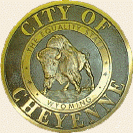

Cheyenne, mile post 509.5 on the Sidney/Laramie Sub.
In June of 1867, there was no sign of any permanent settlement amidst the wind-blown sage and buffalo grass along Crow creek. Vast, rapid changes occurred with the building of the transcontinental railroad. By November 13, 1867, a "Magic City" of 3,000 residents greeted workers bringing Union Pacific railroad tracts to the city limits. On the next day the first passenger train from Omaha arrived.
Like other rail boomtowns, Cheyenne developed a "hell on wheels" reputation for several years. But contrary to this widely held image spread via reporters' colorful narration's of the "wild west" town where "no man ever died a natural death," Cheyenne was not totally given over to violence, gambling, prostitution and murder.
The year 1867 also herald the arrival of the first newspaper, The Cheyenne Daily Leader, the U. S. Post Office, and the First National Bank of Denver. Two months later approximately 300 assorted businesses served an estimated population of 5, 000. Quickly established were churches and the first school, followed by elegant hotels and theaters.
Thanks to the thriving cattle business, " Millionaire's Row" on 17th Street was built and the cattle barons made Cheyenne a cosmopolitan city with international interests. The Cheyenne Opera House seated 1,000 (the current Cheyenne Civic Center seats 1,500) and the Capitol Avenue Theater hosted such luminaries as Sarah Bernhardt. Younger folks rode the streets on high bicycles imported from England and Scotland and the famous Cheyenne Club flourished. Cheyenne owes much of its architectural and cultural heritage to this period.
Along with the livestock business, transportation and mineral industries have played strong roles in Cheyenne's development, with Cheyenne's fortunes and population varying over the years with economic turns of these industries. Cheyenne survived as a transportation hub not only for the Union Pacific Railroad, but also for the Cheyenne-Deadwood stage during the gold rush, and as a major stop on the New York-San Francisco airmail line.
Much of what the early pioneers were forced to bear while taming the West is what visitors and new settlers were now seeking. The economic "booms and busts" are old problems being faced down by new solutions. Cheyenne has come full circle - forging an exciting, energetic city based on its western heritage.
Cheyenne is the home base for Union Pacific's historic collection of vintage locomotives, including two operational steam locomotives which tour various parts of the system each summer. The train depot, nearly a city block long, is being transformed into the Wyoming Transportation Museum. The lobby portion of what is expected to become a world-class museum will open for limited purposes.
Museum organizers hope to open on a grand scale in 1999. Two steam locomotives are available for public inspection in two Cheyenne parks. Big Boy, the world's largest steam locomotive is exhibited at Holliday Park. Engine #1 242 is housed at Lions Park where visitors will also discover a family of bison and elk. The Old West Museum has a Union Pacific Railroad history and video exhibit area as well.
Last Update 07/22/01
This page and its underlying code, © 2000-2001, Wyoming Rails. All rights reserved.